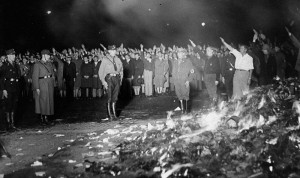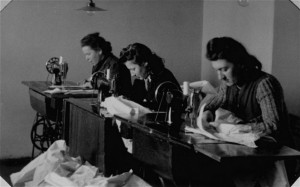May 10, 1933- Burning of books in Berlin
On May 10, 1933, thousands of people gathered in Berlin and across Germany to watch the burning of books. Students from universities gathered work that they and the Nazi party members defined as “un-German spirited.” It is estimated that 40 000 people gathered to watch the burning of books in Berlin alone, with numerous well-known celebrities, such as Einstein joining in. In Berlin, minister Joseph Goebbels declared that the “Jewish intellectual is dead” and that the students could clean the debris of the past.

(German Nazis and a large group of bystanders watching the burning of thousands of books in Berlin)
The burning of books in Berlin and the rest of Germany made a brief appearance in the novel, “The Cage,” when Riva and her brothers discussed the secret library. Books had to be hidden in the ghetto as if they were seen they would be burned and the holder would be punished. They recalled that the German soldiers had taken the majority of the books during the early stages of the ghetto. This quote is evidence that the book burning in Germany was person vs. person or person vs. society conflict. This is evident as the German Nazis are against the Jews and punishing them by destroying their belongings. Although this conflict could be described as a person vs. society as a lot of the non-Jewish society were opposed to Jews and approved of the soldiers’ actions.
September 15, 1935- Nuremberg Race Laws against Jews decreed
On September 15, 1935, that Nazis announced new laws against Jews. The Nuremberg Law was divided into two categories, the Reich citizenship law and the protection of German Blood and German Honor. The regulations banned Jews from marrying or having sexual relations with Germans, requiring identification, and limitations on who could be employed. Anyone who had 3 or more Jewish grandparents were declared as Jewish even if they no longer identified themselves as one. Those who had less than two grandparents who were Jewish could be considered as German or a Mischlinge.
(The system in which Jews were organized as German, Jewish, or a mixture)
http://www.historyplace.com/worldwar2/triumph/tr-nurem-laws.htm
The Nuremberg Laws make an important appearance in the novel, “The Cage,” as Harry, Riva’s old neighbor, no longer wanted to be a part of the Jewish community. He and his family refused to take part in the Jewish holiday Pesach, speak Yiddish, or be part of her family. He referred to himself as German, and relates to his “fatherland.” He and his family turn their backs against Riva’s family and begin taking their warm clothing and oven, practically leaving them to freeze. This quote is evidence that Harry is a dynamic character who goes through change due to conflict. His actions are displayed after he joined the Hitler Youth and was convinced he should fight the Jews. After the war began, his life was put into danger and selected to be German instead of standing up for the Jewish community.
April 30, 1940- The Lodz Ghetto in occupied Poland is sealed off from the outside world with 230,000 Jews locked inside.
On April 30, 1940, not long after the Nazis took over Lodz near Warsaw, the city was sealed off from the outside world trapping more than 230 000 people inside. Wooden barriers and barbed wire were set up around the 1.6-miles city dividing it into two sections, Nowomieskska and B. Limanowskiego. The facility was only meant to be temporary, though it lasted four years with tens of thousands of Jews being brought into the ghetto.
(A group of Jews walking through the overpopulated Lodz ghetto in Germany)
http://www.yadvashem.org/yv/en/exhibitions/communities/bratislava/labor_camps.asp
Lodz being sealed off from the rest of the world made a significant appearance in the novel, “The Cage,” as it is where Riva lived for much of her life and was locked into. Riva was born in Lodz, Germany, west of the city Warsaw with her mother, father, brothers, and sisters. She was born and raised there and later sealed into the ghetto, along with 230 000 other Jews. Barriers and barbed wire fences were set up to keep everyone in the ghetto and prevent anyone from entering or escaping. This quote is evidence that Lodz is a physical setting in the novel. Lodz is one of the locations of Riva’s memoir. This is evident as the time and location were very specific, meaning the author wanted you to imagine the exact location in Poland.
May to December 1940- : Thousands of Polish Jews are sent eastward as forced laborers (to construct fortifications along the new Soviet frontier).
From May to December 1940 thousands of Polish Jews were sent to the east for forced labor. Although deporting Jews to labor camps was common, the Polish Jews of this time were sent to build a defense on the new Soviet border. At labor camps, Jews were forced to do a variety of tasks based on their gender, age, and whether they were working inside or outside of the concentration camp. Tasks included creating clothes for German Nazis, building structures, and working in plantations.
(A group of Jewish men digging in a forced labour camp)
http://www.yadvashem.org/yv/en/exhibitions/communities/bratislava/labor_camps.asp
Jews being deported from ghettos to work in concentration camps made an appearance in the novel, “The Cage,” when it was revealed that Schmulek had worked there and was sent back. He along with many others were promised the safety of their families with extra rations of food. Quite often this never happened, and the families died, were killed, or were deported themselves. Schmulek was accidently returned to Lodz only to find his family gone, and ended up helping Riva and her family. This quote is evidence that Schmulek was a static character as he did not change due to the conflict around him. He originally left the ghetto to help his family stay alive. And even though when he returned they were long gone, he treated Riva and her family like his own. His personality never changed, he was always someone who wanted to do what was best and protect those he cared about.
January to June 1941- 10,000 Jews died by starvation in the ghetto
Between January and June 1941, 10 000 Polish Jews died of starvation in Lodz alone. Rations of food were made even smaller by Nazi policies. Since many people were already sick with diseases, starving did not help them heal. The average rations were no more than 350 calories a day, almost 1650 calories less than needed. After the body hits a certain point it begins to absorb muscles, leading to a painful death not long after.
(A Jewish family posing for a photo in which they are visibly starving)
http://nodisinfo.com/holocaust-era-starvation-pictures-european-jewry-hoax/
Starvation was a recurring theme in the novel, “The Cage,” as many Jews were unable to get the food needed to survive. After being locked in the ghetto for years, food becomes more and more scarce. Families were limited to rations which generally only consisted of a small loaf of bread. Jews were paid for their work with food. So, for those that didn’t work due to illness or lack of employment, often were the first to die of starvation. Numerous people in Lodz died of starvation due to having diseases and not getting the right nutrition and being an orphan. This quote is evidence of person vs. person and person vs. self-conflict. It was always a fight with yourself to stay alive in the ghetto, but with starvation, it became even harder to fight for life. It could also be person vs. person conflict as the Nazis created a policy to limit the food rations, leading to starvation and death.
1942- Jews are forbidden to: subscribe to newspapers; keep dogs, cats, birds, etc; keep electrical equipment including typewriters; own bicycles; buy meat, eggs, or mild; use public transportation; attend school.
In 1942, German Nazis declared that Jews no longer had the right keeping pets, electronics, buy meat or eggs, use public transport, and children could not attend school. Children were forced to attend a secret school in which they could receive homework, grades, and a diploma if they wanted to continue their educations. Jews were not allowed to have typewriters, sewing machines, bicycles, or any electronics that the Nazis felt could be used against them.
Figure 1(Jewish women working on German owned sewing machines as they were not allowed having their own)
http://collections.ushmm.org/search/catalog/pa6247
Jews having their electrical and other belongings by Germans had numerous appearances in the novel, “The Cage,” as new policies were created to limit what they could own. As Riva recalls, no one could have sewing machines in their homes, only the Nazis could supply them. Children were forced to attend secret school if they wanted to attend their education. Riva and her brothers could do this for some time before Riva and Laibele became too ill to go and had to do the basic reading in their own home. This quote is evidence of person vs. person and person vs. society conflict. The Nazis were against the Jews owning certain items due to them fearing that they could revolt against them, leading to them removing them from the community. It is also person vs. society as many non-Jewish people did not want Jews to attend school, they did not want the children to continue their education and take away future jobs.




